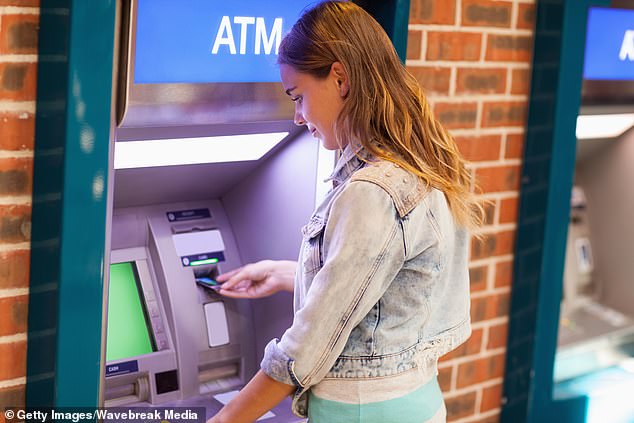
The UK withdrew £81billion from cash machines in 2023, new data from ATM operator Link has revealed.
It marks a fall in total yearly cash withdraws compared to 2022, when UK banking customers withdrew £83billion from cash machines.
Adults over the age of 16 made 975million visits to cash machines last year, amounting to an average of 15 trips per person, withdrawing a total of £1,484 – less than the average of £1,564 in 2022.

Cash is king: Northern Ireland had an average ATM withdrawal per adult of £2,340
The figures show differences in consumers’ cash usage depending where they are based in the UK.
Cash is still king in Northern Ireland, where banking customers withdrew an average of £2,340. This was the only part of the UK to see an increase in cash withdrawals per person in 2023.
The second and third cash-heaviest regions are the North-East, with people there making average withdrawals per person of £1,718, and London where average withdrawals per person totalled £1,684.
ATM usage was lowest in the South West, where the average customer withdrawal was £1,064, followed closely by the South-East, with average customer withdrawals of £1,145.
London is the region with the highest average single withdrawal value at £93, and the second highest part of the UK was Northern Ireland at £91, compared to a UK average of £81.
Graham Mott, director of strategy at Link, says: ‘This is probably because Northern Ireland remains a very high cash use area and it was the only part of the UK to see an increase in cash withdrawn per person last year.
‘This shows that while some people may be using cash less often, most of us still use it occasionally, or keep some for emergencies or special occasions.
‘It’s important to remember that while card and phone payments are convenient for some, there are still around five million people who rely on cash, many of whom will be on low incomes.’

Cashing out: Some people are using cash less often, but many still take it out occasionally or keep some on hand for emergencies
Number of free cash machines plummets
As cash use continues to decline, the number of ATMs has fallen. By the end of 2023, there were five per cent less cash machines than at the end of 2022 and Link expects this number to continue to decrease.
There are currently 38,480 free-to-use machines, down from 40,869 at the end of 2022. There are also 9,921 fee-charging ATMs, down from 10,384 the previous year.
In an average week in 2023, £1.5billion was withdrawn from UK cash machines. This is a sharp drop on pre-pandemic numbers, where £2.2billion was withdrawn in 2019 and LINK does not expect to see a return to these levels.
But there has been a growing trend for increased use of cash in the UK.
Data from industry body UK Finance found that cash usage grew for the first time in a decade last year, and Nationwide Building Society recorded a second annual spike in cash withdrawals from its ATMs.
One reason for the resurgence in cash is that many have returned to budgeting with physical money during the cost of living crisis the British Retail Consortium says.
Despite debit cards being the most popular form of payment, 70 per cent of UK adults say they regularly use cash.
Long term, the trend away from cash is set to continue, though.
Mott adds: We are seeing a steady shift away from cash. Back in 2012 over half of all payments were made in cash but 10 years later, its only around 15 per cent.
‘That’s a big change in consumers’ behaviour and as a result we have seen cash machines starting to close in areas where there is a surplus.
‘We would expect this trend to continue. However, Link’s job is to make sure that we protect the overall coverage of ATMs.
What’s important is that we protect the last ATM in the smallest town or village
‘High streets that may have had 20 ATMs may now only have five to ten. Likewise, you may notice that at supermarkets, three machines have been reduced to one or two.
‘What’s more important is that we protect the last ATM in the smallest town and village. We protect more than 2,500 ATMs in some of the most deprived and rural areas across the UK.’
The Financial Conduct Authority recently proposed new rules to protect access to cash in Britain.
Under the proposals, designated banks and building societies will have to assess gaps in access to cash.
Where the assessments show there is a significant gap in a town or that there could be in the future, banks and building societies will be required to deliver additional cash services to fill gaps.
Banks and building societies will need to ensure they do not close cash facilities, including bank branches, until any additional cash services identified are available.
Some links in this article may be affiliate links. If you click on them we may earn a small commission. That helps us fund This Is Money, and keep it free to use. We do not write articles to promote products. We do not allow any commercial relationship to affect our editorial independence.






